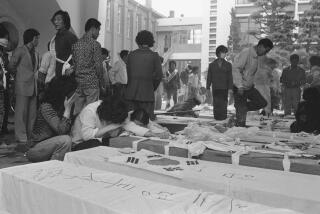Helsinki’s Old World Face a Facade to Some
Helsinki is struggling to maintain an Old World dignity alongside its nightclubs and neon-lighted shopping arcades. But some citizens complain it’s all just a facade.
And it is.
Old World Helsinki still rides along in trolley cars that rattle along broad, cobbled streets on rails laid at the turn of the century, and they are more popular and reach more places than buses or the city’s one subway line.
Built on a peninsula jutting into the Baltic Sea, Helsinki has a population of a half million and serves another half million in satellite towns.
The bulging population has forced city officials to grapple with the problem of accommodating 20th-Century needs in 19th-Century premises and to keep the graciousness of an age when buildings were the works of craftsmen.
City Hall’s solution was to issue building plans ordering that the street-side facades of old structures must be preserved while owners remain free to do what they want with the rest.
That has led to the gutting of the interiors, which is easier, cheaper and more functional than restoring the elegant old apartments and turning them into offices, said city architect Runo Tyynila.
“Some people are horrified,” Tyynila said in an interview. “(They say) this isn’t preservation; this is only for scenery. You think you are walking into an old building, and everything is new.”
Supplies Diplomats
Next door to the Stockmann department store, a 50-year landmark that supplies much of Moscow’s diplomatic community by mail order, steel beams prop up a five-story, red-brick wall with windows framed in sculptured plaster.
Behind it is nothing but industrial rubble. At least a dozen other buildings are in a similar state of disassembly.
Helsinki was founded in 1550, but the city was destroyed again and again by fire and plague. Most of the oldest surviving structures were built in the early 1800s when Finland became an autonomous Russian duchy.
It still has a Russian flavor, which travelers compare to Leningrad, a five-hour ferryboat ride away across the Gulf of Finland.
The plan to preserve the old facades came after a period of widespread demolitions of old buildings in the 1960s. Glass-encased shopping malls, like the Forum on Mannerheim Street, were built to compete with the traditional department stores like Stockmann.
The Forum features boutiques blaring disco music, modernistic fountains and fast-food outlets. The Finland Business Report magazine said three more shopping arcades are now planned for the eastern side of old Helsinki.
Finns Had Second Thoughts
Tyynila said Finns had second thoughts about tearing down the old buildings when they began to miss them.
“The attitude before was to get rid of old buildings. We can build better ones. Now it is going the other way,” she said.
The first beneficiary of the preservation plan was City Hall itself, which was remodeled and modernized inside its old shell in a project completed in 1970.
The city has encountered some grumbling from owners who must incur the added expense of preservation.
Tyynila said “it has happened now and then” that some old buildings burned to the ground under mysterious circumstances.
But she added that owners wind up making enormous profits when they convert their old buildings into new downtown offices or shops. Preserving the facade, she said, “doesn’t cost much compared with the total.”
More to Read
Start your day right
Sign up for Essential California for news, features and recommendations from the L.A. Times and beyond in your inbox six days a week.
You may occasionally receive promotional content from the Los Angeles Times.






